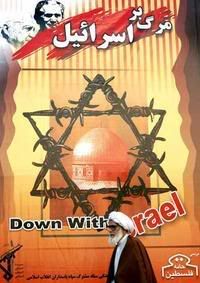LA Times Takes Iran's Side In Nuke Debate
 The lead story in Sunday's LATimes is nothing more than an apologist statement for Mahmoud Ahmadinejad and his policies, built (natch!) on criticism of the US administration:
The lead story in Sunday's LATimes is nothing more than an apologist statement for Mahmoud Ahmadinejad and his policies, built (natch!) on criticism of the US administration:VIENNA — Although international concern is growing about Iran's nuclear program and its regional ambitions, diplomats here say most U.S. intelligence shared with the U.N. nuclear watchdog agency has proved inaccurate and none has led to significant discoveries inside Iran.Taking the suppoposed dearth of "real evidence" of a nuke program, the LAT extrapolates to posit that there is no clear evidence for Iranian support of Shi'ite groups in Iran or for Hezbollah in Lebanon. Forget that Iranian trainers are captured in these places, forget that Iranian-manufactured munitions are found there -- and used to kill innocents and warriors against Islamist totalitarianism -- the lack of "real evidence" makes it all doubtful.
The officials said the CIA and other Western spy services had provided sensitive information to the Vienna-based International Atomic Energy Agency at least since 2002, when Iran's long-secret nuclear program was exposed. But none of the tips about supposed secret weapons sites provided clear evidence that the Islamic Republic was developing illicit weapons.
"Since 2002, pretty much all the intelligence that's come to us has proved to be wrong," a senior diplomat at the IAEA said. Another official here described the agency's intelligence stream as "very cold now" because "so little panned out."
The reliability of U.S. information and assessments on Iran is increasingly at issue as the Bush administration confronts the emerging regional power on several fronts: its expanding nuclear effort, its alleged support for insurgents in Iraq and its backing of Middle East militant groups.
What would be "real evidence" to the LAT? A nuclear device with "Made in Iran" stamped on it? We haven't found that yet. How about all that "wipe Israel off the map" hysteria? Does the LAT and the IAEA think they intend to do that with a few tanks and conventional missiles?
Well, lacking that "real evidence," how about a notebook -- like the Giuliani campaign strategy notebook -- with all the details of Iran's nuke ambitions? Well, it turns out the IAEA pretty much found at least part of such a notebook already, and the LAT acknowledges as much:
In November 2005, U.N. inspectors leafing through papers in Tehran discovered a 15-page document that showed how to form highly enriched uranium into the configuration needed for the core of a nuclear bomb. Iran said the paper came from Pakistan, but has rebuffed IAEA requests to let inspectors take or copy it for further analysis.Seems a tad suspicious, as does this:
Diplomats here were less convinced by documents recovered by U.S. intelligence from a laptop computer apparently stolen from Iran. American analysts first briefed senior IAEA officials on the contents of the hard drive at the U.S. mission here in mid-2005.Vienna is dismissing the hard-drive because the documents are in English? If they'd been in Klingon, I would have been suspicious, but since English is the language of science, this isn't a deal-killer to me. Besides, did no one in Vienna or the LAT think to follow up on the matters Soltanieh avoided in his "Green Salt" answer -- ballistic missile upgrades to make them nuke-capapble, and drawings of subterranean testing facilities?
The documents included detailed designs to upgrade ballistic missiles to carry nuclear warheads, drawings for subterranean testing of high explosives, and two pages describing research on uranium tetrafluoride, known as "green salt," which is used during uranium enrichment. IAEA officials remain suspicious of the information in part because most of the papers are in English rather than Persian, the Iranian language.
"We don't know. Are they genuine, are they real?" asked a senior U.N. official here. Another official who was briefed on the documents said he was "very unconvinced."
Iran's representative to the IAEA, Ali Asghar Soltanieh, dismissed the laptop documents as "fabricated information." Iran, he said, has produced 170 tons of "green salt" at a uranium conversion facility in Esfahan that is monitored by the IAEA.
"We are not hiding it," he said in an interview. "We make tons of it. These documents are all nonsense."
The LAT goes on to dismiss Iranian supply of explosively formed projectiles because of US backtracking on one statement about the decision to provide EFP's was traceable to the "highest levels" of Iranian leadership. So? Supply is supply; Iran is Iran. We're sure they're not coming from repressed pro-democracy groups in Iran.
Also dismissed is Iranian supply of Hezbollah, despite overwhelming evidence. Just how it's dismissed isn't explained by the LAT. They just bring up the allegation and let it stand unchallenged, surrounded by challenged allegations. They appear afraid to draw conclusions from something anti-Iranian they can't refute.
The big question: Why?
Even though the article concludes with a fine quote --
"The Americans are worried about enriched uranium, and the Arabs are worried about enriched Shiism," said Mamoun Fandy, senior fellow for Persian Gulf security at the London-based International Institute for Strategic Studies. Iran's growing power, he said, "threatens every existing political order in the region."-- it's evident that the editors and publisher of the LAT are convinced by their Bush hatred that a US attack on Iran is imminent. The article is thrown out as a journalistic EFP, trying to kill a policy boogeyman that doesn't exist, but scares them.
Bush and his leadership can say "No, no, no, no, no" to questions about plans to attack Iran, but because they think Bush is a liar (he's not, of course), they don't believe him, so they find themselves defending Tehran and slamming America -- and the LAT journalistic elite seem to be quite happy being there.
Labels: Bush, Foreign policy, Iran, Media bias, MSM




<< Home